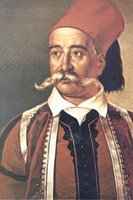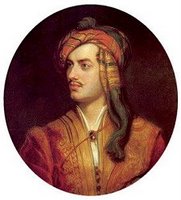Patriotism without political correctness: it still exists!
 Today won an hour due European bureaucracy insisting on maintaining summer time, which ends end October when the lost hour is finally reimbursed. This gave me the opportunity to revisit the Greek National Historical Museum (here is the link to the site, but it suffers from a lamentable lack of good pics: http://www.culture.gr/4/42/421/42103/42103e/e42103e1.html).
Today won an hour due European bureaucracy insisting on maintaining summer time, which ends end October when the lost hour is finally reimbursed. This gave me the opportunity to revisit the Greek National Historical Museum (here is the link to the site, but it suffers from a lamentable lack of good pics: http://www.culture.gr/4/42/421/42103/42103e/e42103e1.html).
It is housed in the first parliament building and cohabits the Historical and Ethnological Society of Greece. The latter is of no consequence here, but to offer a great opportunity to point to a peculiar Greek habit of transcribing Greek words literally to English without actually translating them. I think it is rather charming and saves you the trouble of having to learn the word in Greek.
Apart from the quite unashamed patriotism (a lurking irritant to the E.U., which is genetically allergic in all sorts of ways for what they term nationalism with a capital N,) especially touching are the cloth and textile artifacts: ragged flags from wind-torn battle-fields, with the words "freedom or death" or "unity or death" like a solemn prayer or pledge in calligraphic letters stitched on them by tiny women's fingers; the gold embroidering loosened and worn, the once fiery crimsons faded to a shaded pink, bearing crosses, laurel wreaths, palms, crowns and swords as promises of the nation restored, that all will be well.
What also stands out are these huge paintings of the national heroes, Kolokotroni, Mavromichalis, Katsonis, Botsaris and Makrigiannis, the fighting men of the War of Independence (1821-1827) and the making of the Greek nation state, when the ships were of wood and the men made of steel. Compare these towering and impressively mustached figures in their armor and weaponry to the costumes still in tact from that time and the contrast couldn't be bigger: tiny shoes and booties, sweet little shirts and beautifully embroidered coats and vests: these towering giants were in fact very small people, the size of children! You tend to think they'd have some dwarvish characteristics, but this is all wrong: all proportions are quite common, just a whole lot smaller! The effect is that a fairytale-like alienation creeps up upon the onlooker.
Guess whom I met there, a bit out of place and in a glorified broom cupboard? A statue of the last Byzantine emperor, Constantinos Palaiologos, a relative of Manuel II Palaiologos of Pope Benedict XVI fame! (For those who enjoyed a modern education, Byzanthium was the seat of the Eastern Roman Empire and was situated in Greece and the Near East; the capital was Constantinople, present day Istanbul; it flourished roughly from A.D. (= Anno Domini = the year of our Lord) 324 until 1453 when it was finally disastrously overrun by the Ottoman Turks, who originate much further east, probably present day Kazachstan or even further afield Mongolia - but enough historical perspective for one day, which one should never overdo).
I leave you this Sunday with a picture of the old charmer, philhelene Lord Byron, who made the Greek struggle for independence something of a fad in Europe. Here's a link to the site: http://www.englishhistory.net/byron.html













No comments:
Post a Comment